Lesson 5: Fermentation and the Origins of Energy Balance Experiments
No doubt, it’s strange to hear for the very first time, “Fermentation is occurring right now within your intestines and muscles.”
Consider a typical probiotic supplement available at a health food store. Notice the package label does not list the word ‘bacteria’ or say ‘10 Bacterial Strains’. But it does say ‘10 Probiotic Strains’ read just below ‘25 Billion’. Eating bacteria does not sound as appetizing as eating probiotics or as beautiful as flora. Bacteria in your intestines = probiotics.
Probiotics or bacteria are tiny organisms that transform carbohydrate into a variety of acids.
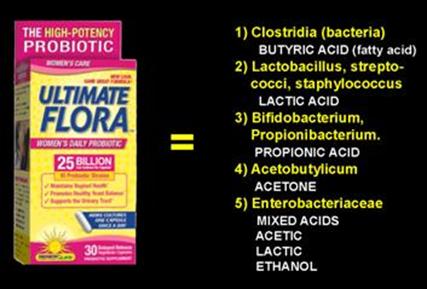
The yellow text above lists the bacteria living in your intestines, including some that live in your mouth. The white text represents the ‘poop’ produced by bacteria after feeding on carbohydrate. One man’s waste is another man’s treasure; these ‘wastes’ benefit your health and immune system because acids are antimicrobial.
Lactic acid is just one of several acids produced within your gut. The sharp distinctive taste in yogurt, kefir, and buttermilk is lactic acid. Lactobacillus is the ‘live active culture’ or bacteria commonly listed on a yogurt label. Lactobacillus ferments sugar in milk into lactic acid.
Notice streptococci also ferments sugar into lactic acid. ‘Strep’ is always present in your mouth in low amounts, ready to feed on sugars you eat. Between visits to the dentist this bacteria multiplies and builds up into the plaque (or biofilm) that accumulates on the border of your teeth and gums, unless you decide to scrape it off by yourself. Bacteria live in many places on our body and regularly buildup into a bacterial community called biofilms, e.g. mucus like coatings on the trachea, vagina, prosthetic metal hip replacements, and slime on teeth or rocks in a stream. Biofilms can be beneficial or harmful, just like ‘good’ or ‘bad’ bacteria.
Frame 1 below shows the monthly alteration in the vaginal biofilm community that corresponds to menses each month. Frame 2 shows biofilm coating a platinum wire, similar to the growth on metal hip replacements. Frame 3 shows the biofilm living in the appendix, readily available for release into the proximal colon if ‘good bacteria’ populations in the colon need ‘help to replenish’ or fight infection. Notice the word ‘mucin’ in frame 3, similar to mucus, which builds up in our throats and nasal passages when we fight infections.

Many other important lessons on nutrition and exercise science require knowing where gut flora live within the intestinal tract in cows and humans. For example, if greater numbers of bacteria lived in the upper section of the small intestine, we would absorb much less calories due to bacteria consuming food before we could absorb this energy into our blood stream. Weight loss and starvation would result. As shown before, the darker shaded areas correspond to higher population density of gut bacteria and higher rates of fermentation.

As shown in lesson 1, carbohydrates ferment into lactic acid within the ‘bacterial section’ of your muscle cells. Below: A student’s hand drawn ‘muscle cell’. The cytosol of the cell is labeled ‘bacterial region’.
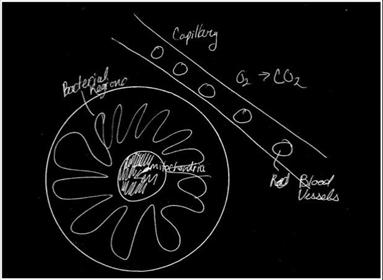
Unfortunately, modern people commonly view fermentation narrowly or in a restricted sense, namely as just a way to make alcohol. This is the fault of modern scientists and writers who quit using the word fermentation in books and articles on nutrition and exercise. Fermentation classically refers to cellular conversion of sugar to lactic acid during anaerobic metabolism. Hence, early investigators used the words ‘sugar fermentation’; today’s term is glycolysis.
In the early 20th century, the language used to describe physiology and nutritional events was the same as describing natural, familiarly known physical phenomena. For example, aerobic metabolism and respiration was referred to as ‘combustion of food stuffs’ as if burning wood or coal. This crossover mentality resulted in experiments and their subsequent description to be congruent with the common man’s perception. Moreover, it was unnecessary to tell people they were learning some sort of special ‘integrated form’ of nutrition. Below, milk burns in a locomotive firebox similarly to combusting food stuffs within a human muscle cell. When combusted, energy in milk converts to heat, within our body or in a firebox.
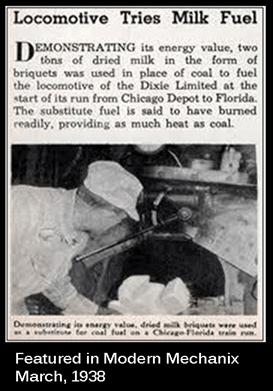
The common man’s psyche and the physician’s education once developed from common roots – language and experience wise. Consider the fact over 90% of Americans once farmed. Most people understood fermentation and fermented foods, directly from experience. For example, farm children carried buttermilk into the kitchen after milk fermented. People learned through smell, taste, and touch; many things grown ferment. Icky, smelly stuff was part of the home environment. Using a historical perspective, we see why scientists used the word ‘fermentation’ and why virtually everyone – even children – would not be completely baffled by the scientist’s statement, “Muscles ferment carbohydrates into acid during high intensity exercise.” Tell kids the acid in muscles is the same acid that produces the distinctive taste in yogurt, buttermilk, and specific other foods and they got the idea transformations in the body mirror transformations in nature. Child or adult – it is not important or necessary to examine the details of the chemical reaction at first; it is more important to realize connections.
In such an early stage of scientific exploration when scientists, educated people, or farm-raised ‘uneducated’ folks remained connected by words and experience, most anyone could concretely understand scientific descriptions of how the body works. But when modern scientists and writers living in a fragmented age of specialization no longer themselves know the natural phenomena or the words to make useful comparisons, then an integrated view of the world diminishes. Strict definitions are practically useless in the early stages of learning. For example, ‘glycolysis’ – defined as the splitting of glucose into pyruvic acid – provides no sensible or contextual meaning to a person. But when people learn sugar in grapes ferment into alcohol (wine), probiotics in the gut ferment sugar into acids, and muscles ferment sugar into acid too, the entire physical world becomes a cohesive picture that makes ‘more sense’.
As words like fermentation and combustion were abandoned through the 20th century, new terms, new foods, new perceptions, and new science degrees were concomitantly created. Glycolysis replace fermentation, margarine replaced butter. The rise of the exercise physiologist, nutritionist, and athletic trainer coincided with industry growth, technological advances in medicine and sports, and mounting pressure on kids to play a single sport year round.
Throughout the 20th century companies like the Newfoundland Butter Company, General Mills and Pillsbury spawned a cornucopia of supposedly new healthy foods like margarine and low or no-calorie foods through the creative powers of the food scientist. Coincidentally, the general practice MD and celebrity pitchmen like William Shatner espoused the promise of margarine and the heart-health benefits of trans-fat laden ‘manufactured oils’. Hydrogenated fat became suitable for the Betty Crockers of America who loved baking pies and were convinced not to use lard or butter. New paradigms replaced old paradigms. The food pyramid replaced the four food groups. Clever ways to follow new rules were devised to fit with how new foods ‘worked’. Dietitians and other institutional lackeys dispense advice based on guidelines and pyramid schemes, created not by competent scientists but by big government and lobby groups. Now we have food engineers, fish and flax-seed oil, aka linseed oil or varnish, and GMO’s.
Viewing the way food actually works within the human body – based on physics – became obfuscated by redirecting people to focus on the possibility and fear of acquiring ‘negative health outcomes’ based on risk factors. Eating to prevent disease became a ‘lifestyle’ aimed to avoid the spectre of harm associated with risk factors and supposed genetic pre-determinism – as opposed to intentionally ‘eating to promote health’ based on how foods and environment change expression of genes after we are born. People aim to not hit the tree or avoid the water when teeing off. Fear is the motivator; avoidance of sickness or the hazard, as opposed to communing with physical regeneration or the fairway is a goal for many people. Epidemiology the dirty science became the ‘gold standard’ for medicine and for creating guidelines of nutrition. The divorce between physics and medicine was filed for decades ago. As a result, fat or oil – the main fuel for the body – is no longer recognized as ‘healthy fuel’ for the body.
Fat and oil are two words used to describe the same substance. For example, just because vegetable oil becomes solid via hydrogenation does not mean it is no longer ‘oil’. We just call oils ‘fat’ just as we call ice, ‘ice’ – not water – in order to clarify our physical perception. Muddying the waters further regarding the perception of ‘healthy fat’ is the fact oils used for varnishing wood and seasoning cast iron pans, e.g. fish oil and flax-seed oil now sell in health food stores. Traditionally, these oils are called drying oils because they react with oxygen and ‘dry up’ into varnish. Researchers call these fats ‘anti-inflammatory’ but may fail to realize this is synonymous with suppressing the immune system. Anti-inflammatory oils, like cortisone injections for injured athletes may be good for short term relief, but not for long term health and healing. This writer knows these statements may bewilder ‘educated’ modern thinkers because he too stood in other shoes and did not know the physics, chemistry, or history of oil, metabolism, and physiology. In order to gain a clear understanding of the present situation it is wise to examine original research.
We digress. Winding back the clock to the late 1800’s we see nutritionists and exercise scientists did not exist in name but did in practice, as formally trained chemists, physiologists, and physicists. And if we return to a point in time where nutrition and exercise science in its modern integrated form originated, we see one man named W.O. Atwater, an agricultural chemist.
A cursory look at the words Atwater to describe food, calories, energy, and regeneration of the human body demonstrates ‘straight physical talk’. “Food may be defined as material which, when taken into the body, serves to either form tissue or yield energy, or both. This definition includes all the ordinary food materials, since they both build tissue and yield energy. It includes sugar and starch, because they yield energy and form fatty tissue. It includes alcohol, because the latter is burned to yield energy, though it does not build tissue. It includes creatin, creatinin, [sic] and other so-called nitrogenous extractives of meat, and likewise caffeine of tea and coffee, because they neither build tissue nor yield energy, although they may, at times, be useful aids to nutrition.” W.O. Atwater: 1905, pictured below.

Even non-scientist writers from the past described the physiology of weight loss and thermodynamics in a ‘superior scientific way’ compared to modern scientists and writers. For example, read chapter 1: Preliminary Bout in a book written by Lulu Hunt Peters in 1918 – click this link. She uses the term ‘fireless cooker’ to describe the lack of heat loss in people who have trouble losing weight, which is not only brilliant, but also explains why so many modern scientists fail to understand the fundamental physics of weight loss and calories. Studying physics is not primarily about examining the origins of the universe; it was and still is simply studying anything and everything physical, human body included. The word physician derives from the art and science of practicing physics. To ‘take a physic’ once meant to swallow medicine. ‘Physical training’ is practicing physics. The study of physics, exercise science, and nutrition were one and the same to the seminal researchers from the past.
Look no further to seek the seminal research. The next section shows photographs from the ‘original energy balance experiments’ and briefly describes the essentials of metabolic science and exercise physiology. This is to warm up to examining nutrition and exercise science in a new, ‘old’ way.
Now we have traced back to the origin of energy balance experiments. The photo below resulted from experimental studies on food and humans conducted by Atwater and Benedict in the late 1800’s and early 1900’s. By 1906, Benedict, a physiologist and magician mastered the modern technique use to calculate the quantity of carbs and fat burned by the body during rest or exercise.
This man exhaled into a mask in order to collect the carbon dioxide (CO2) expelled from his lungs with each breath. The scientists Atwater and Benedict compared the volume of CO2 expelled to the volume of oxygen he consumed in order to quantify carbohydrate and fat used by his body at any intensity level.
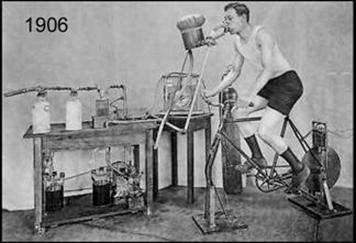
Still to this day, you must wear a mask to measure the volume of oxygen breathed and the carbon dioxide breathed out.
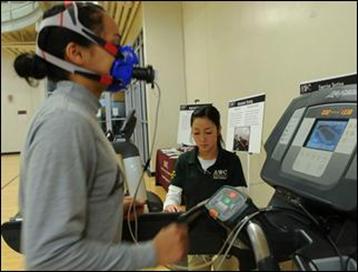
Comparing the volume of one gas breathed out (carbon dioxide) to one gas breathed in (oxygen) is called the Respiration Exchange Ratio or RER for short. This is expressed in a ratio: [CO2/O2] The reason why RER exists is absurdly simple. Our cells consume O2 and then we blow out CO2. That’s it.
Within a muscle cell (or any cell) the chemistry of respiration is essentially a slower form of combusting a log in a fire. The chemical reaction in words is: Fuel combines with oxygen and produces the waste products CO2, H20, and Heat.
Any combustible fuel, e.g. coal, wood, milk, or coffee burns as long as oxygen is present – as demonstrated by the experiments below.

Practically all children learn the physics of creating fire. Do we not tell children, “throw some fuel on the fire!”?
Calories were once called ‘Atwater Factors’. For a time his name was synonymous with the word calorie. Atwater’s calculations of the energy content of food made it possible to quantify how much energy humans used in terms of calories in and calories out.
Below is the actual copy from a popular magazine called New Century where the word ‘calorie’ appeared the first time ever in American print; published 1887. He indicated the heat contained in food (in calories per gram) for carbohydrate, protein, or fat as we know it today. Approximately 4 cal/g for protein and carbohydrate and 9 cal/g for fat.
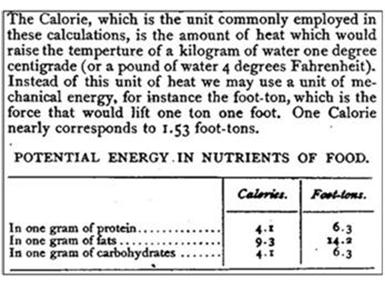
Hence, the modern ‘Nutrition Facts’ label and modern listings for energy content in food derives from experiments calculated by Atwater, indicated as ‘fuel values’. The data below is still used today by commercial enterprise because it’s accurate.
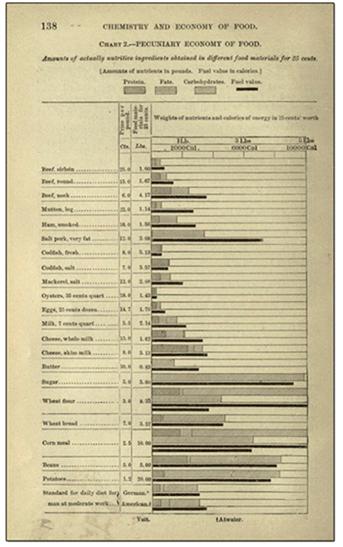
Atwater was paid $7,500 (in early 21st century money) for each single article, (in a series of five articles) named The Chemistry of Food and Nutrition.
Imagine not ever hearing the names Isaac Newton or Albert Einstein when it comes to even the most casual learning environment on gravity, physics, light, or the universe. By casual, I mean just sitting around the campfire and musing over gravity, god, or existence while star gazing or trash talking to put someone down, “You ain’t no Einstein.” My point is omitting Atwater and Benedict’s names from the curriculum of any modern medical, nutrition, or exercise science exercise/sports science field (where you need to learn the most essential things like force, food, power, calories, speed, and energy) is equivalent to omitting Newton and Einstein from the books and lectures of the physics world. Keep in mind physics is the root word of physician and physiology.
Atwater’s human metabolism experiments were considered to be the dream project for the 19th century; he was perhaps the most famous scientist in the U.S. during the late 1800’s. However, some of the earliest metabolic experiments on humans were conducted in the 1770’s by Antoine Lavoisier. (Lavoisier later lost his head to the guillotine.)
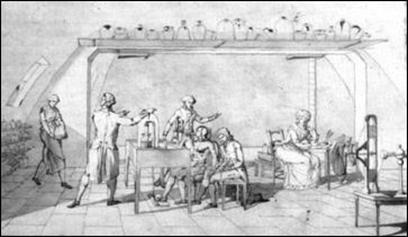
Flash forward back to the 21st century. Gut flora education, probiotic supplements, and fermented drinks like kombucha have made a comeback. Although many people eat bacteria for health reasons, many people do not realize bacteria need to eat and do not realize properly feeding gut bacteria is more important than eating bacteria directly.
Bacteria do not eat themselves; they eat sugar or ‘prebiotics’. If you have a healthy and vigorous gut flora population, taking a probiotic supplement is as powerful as a fart in a hurricane. You are just adding a tiny fraction of bacteria to the billions already there.
Bacteria and muscle cells ferment carbs into acids at all times; this is why lactic acid is always present in our blood in small amounts at rest and high amounts during high intensity exercise.
High intensity exercise is just fermentation speeded up within a muscle, as cells have a feeding frenzy on sugar.
The present often circles back to the past. Atwater and people in his time used the word ‘ferment’ to describe muscle metabolism. Now we do too. Using this word is more sensible because it paints a more physically coherent picture in terms relating ‘like events’ occurring within guts, muscles, a beer fermentation vat, or anywhere else within or on your body where bacteria live and eat.
As we go forward, we’ll continue to use words and imagery to build a greater picture.
